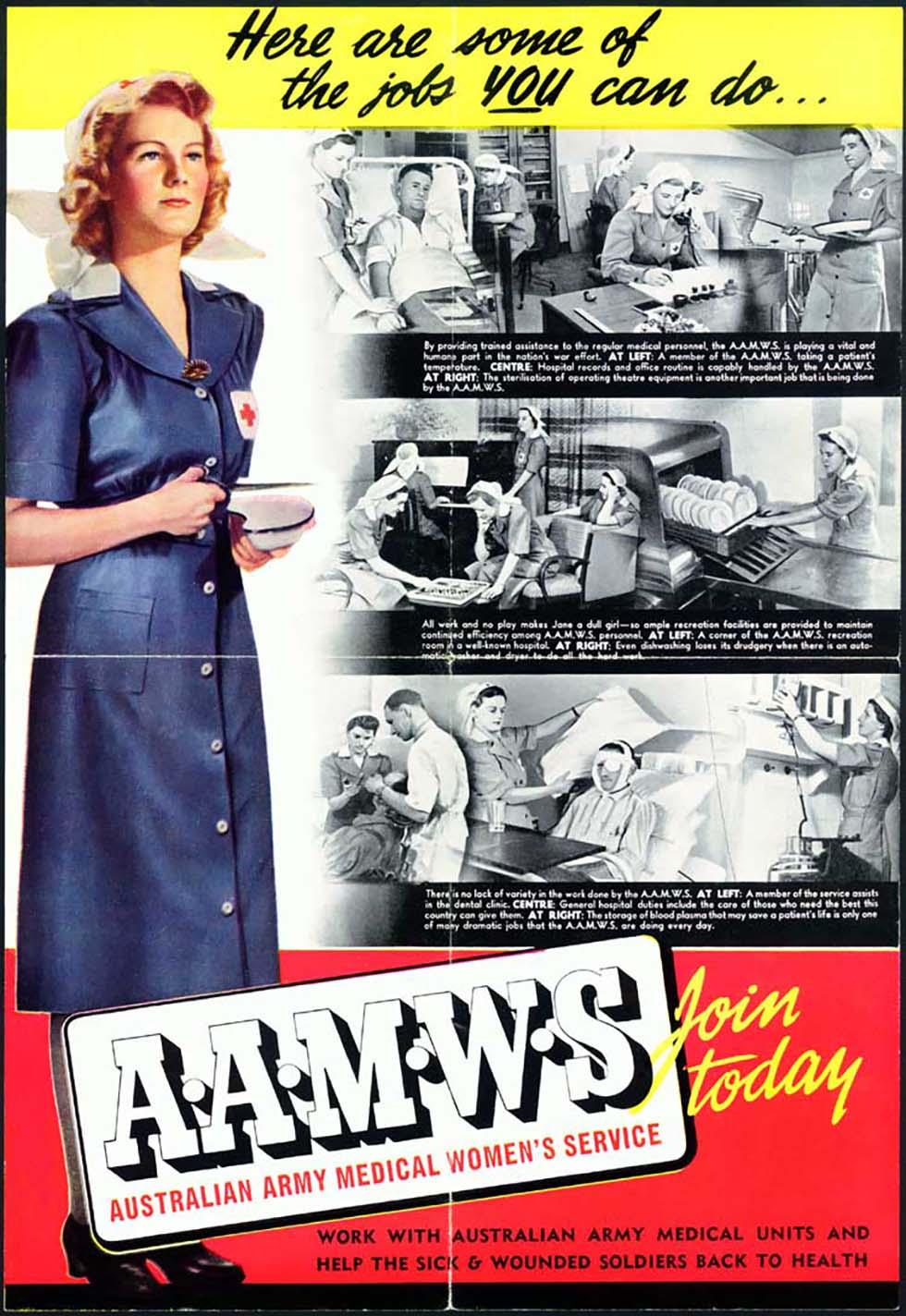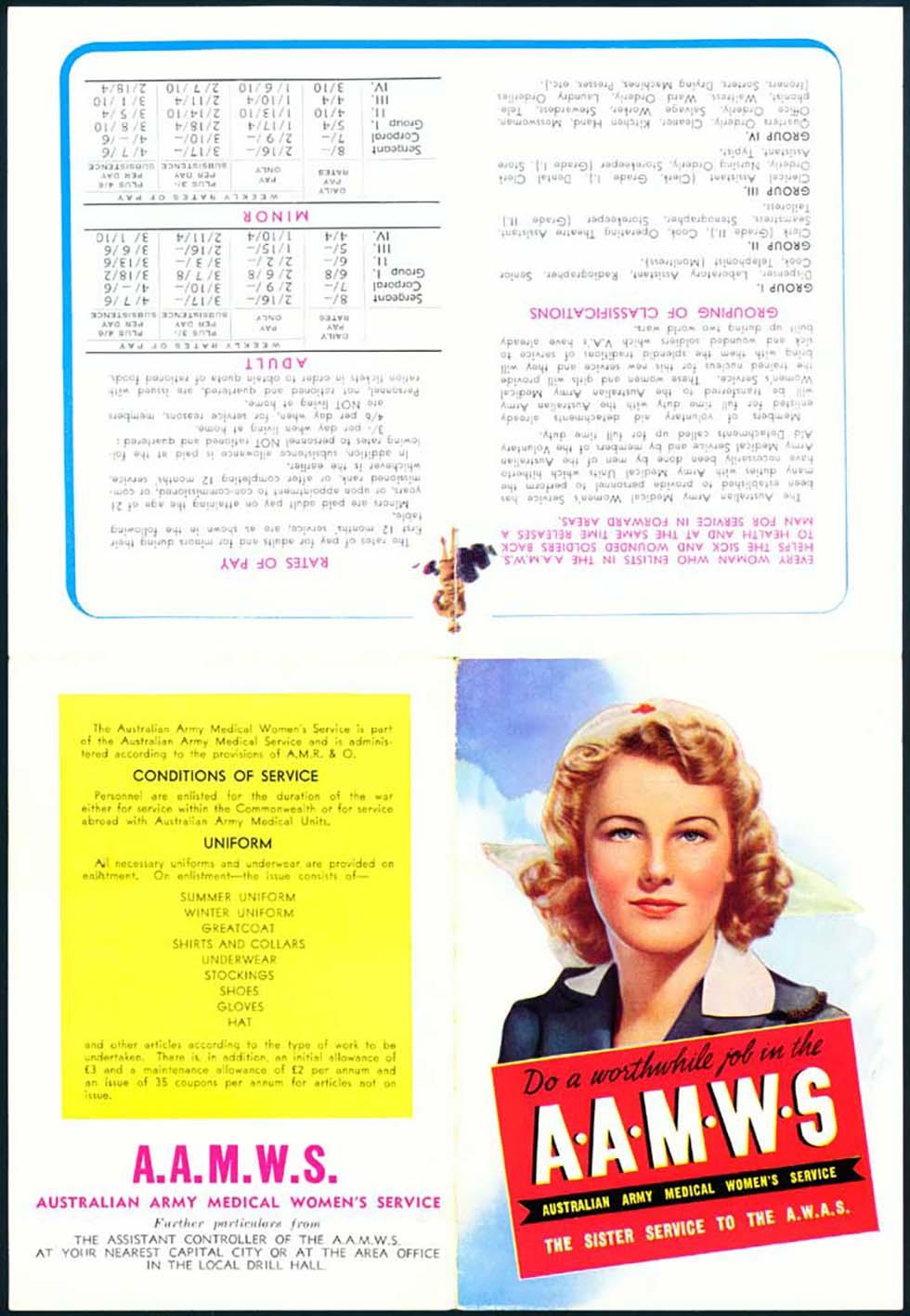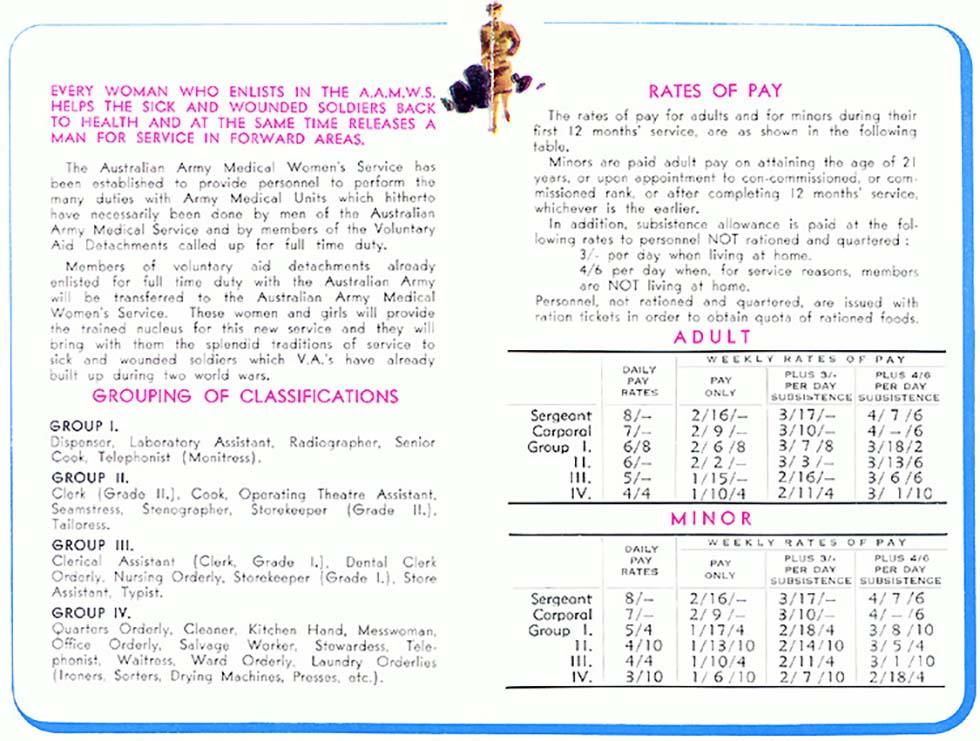


Aboriginal and Torres Strait Islander people should be aware that the National Archives' website and collection contain the names, images and voices of people who have died.
Some records include terms and views that are not appropriate today. They reflect the period in which they were created and are not the views of the National Archives.




[Document is a poster, with text printed on the back so it can be folded into a four-page booklet]
[Poster]
[Heading in italicised text on yellow background] Here are some of the jobs YOU [underlined] can do…
[Along left edge of poster, a coloured picture of a woman in a blue nursing uniform.]
[Composite of three black and white photographs with the following caption:] By providing trained assistance to the regular medical personnel, the A.A.M.W.S. [Australian Army Medical Women’s Service] is playing a vital and humane part in the nation’s war effort. AT LEFT: A member of the A.A.M.W.S. taking a patient’s temperature. CENTRE: Hospital records and office routine is capably handled by the A.A.M.W.S. AT RIGHT: The sterilisation of operating theatre equipment is another important job that is being done by the A.A.W.M.S.
[Composite of two black and white photographs with the following caption:] All work and no play makes Jane a dull girl – so ample recreation facilities are provided to maintain continued efficiency among A.A.W.M.S personnel. AT LEFT: A corner of the A.A.W.M.S. recreation room in a well-known hospital. AT RIGHT: Even dishwashing loses its drudgery when there is an automatic washer and dryer to do all the hard work.
[Composite of three black and white photographs with the following caption:] There is no lack of variety in the work done by the A.A.M.W.S. AT LEFT: a member of the service assists in the dental clinic. CENTRE: General hospital duties include the care of those who need the best this country can give them. AT RIGHT: The storage of blood plasma that may save a patient’s life is only one of many dramatic jobs that the A.A.M.W.S. are doing every day.
[On red bar across the bottom of the poster, a large white ‘label’ reading ‘A.A.M.W.S AUSTRALIAN ARMY MEDICAL WOMEN’S SERVICE’. In yellow italics, overlapping the edge of the label and the red background, ‘Join today’. In black text at the bottom of the red section, ‘WORK WITH AUSTRALIAN ARMY MEDICAL UNITS AND HELP THE SICK AND WOUNDED SOLDIERS BACK TO HEALTH’.]
[Page 1 of booklet]
[Image of a woman in a blue nursing uniform]
Do a worthwhile job in the
[Main heading] A.A.M.W.S
AUSTRALIAN ARMY MEDICAL WOMEN’S SERVICE
THE SISTER SERVICE TO THE A.W.A.S. [Australian Women’s Army Service]
[Page 2 of booklet]
The Australian Army Medical Women’s Service is part of the Australian Army Medical Service and is administered [sic] according to the provisions of A.M.R. & O. [Australian Military Regulations and Orders].
CONDITIONS OF SERVICE
Personnel are enlisted for the duration of the war either for service within the Commonwealth or for service abroad with Australian Army Medical Units.
UNIFORM
All necessary uniforms and underwear are provided on enlistment. On enlistment – the issue consists of –
SUMMER UNIFORM
WINTER UNIFORM
GREATCOAT
SHIRTS AND COLLARS
UNDERWEAR
STOCKINGS
SHOES
GLOVES
HAT
and other articles according to the type of work to be undertaken. There is, in addition, an initial allowance of £3 and a maintenance allowance of £2 per annum and an issue of 35 coupons per annum of articles not on issue.
[Large text] A.A.M.W.S.
AUSTRALIAN ARMY MEDICAL WOMEN’S SERVICE
Further particulars from
THE ASSISTANT CONTROLLER OF THE A.A.M.W.S.
AT YOUR NEAREST CAPITAL CITY OR AT THE AREA OFFICE IN THE LOCAL DRILL HALL
[Page 3 of booklet]
[In large pink text] EVERY WOMAN WHO ENLISTS IN THE A.A.M.W.S. HELPS THE SICK AND WOUNDED SOLDIERS BACK TO HEALTH AND AT THE SAME TIME RELEASES A MAN FOR SERVICE IN THE FORWARD AREAS.
The Australian Army Medical Women’s Service has been established to provide personnel to perform the many duties with Army Medical Units which hitherto have necessarily been done by men of the Australian Army Medical Service and by members of the Voluntary Aid Detachments called up for full time duty.
Members of voluntary aid detachments already enlisted for full time duty with the Australian Army will be transferred to the Australian Army Medical Women’s Service. These women and girls will provide the trained nucleus for this new service and they will bring with them the splendid traditions of service to sick and wounded soldiers which V.A.’s [Voluntary Aides] have already built up during two world wars.
[In large pink text] GROUPING OF CLASSIFICATIONS
GROUP I.
Dispenser, Laboratory Assistant, Radiographer, Senior Cook, Telephonist (Monitress).
GROUP II.
Clerk (Grade II.), Cook, Operating Theatre Assistant, Seamstress, Stenographer, Storekeeper (Grade II.), Tailoress.
GROUP III.
Clerical Assistant (Clerk, Grade I.), Dental Clerk Orderly, Nursing Orderly, Storekeeper (Grade I.), Store Assistant, Typist.
GROUP IV.
Quarters Orderly, Cleaner, Kitchen Hand, Messwoman, Office Orderly, Salvage Worker, Stewardess, Telephonist, Waitress, Ward Orderly, Laundry Orderlies (Ironers, Sorters, Drying Machines, Presses, etc.).
[Page 4 of booklet]
[In large pink text] RATES OF PAY
The rates of pay for adults and for minors during their first 12 months’ service are as shown in the following table.
Minors are paid adult pay on attaining the age of 21 years, or upon appointment to con-commissioned [sic - possibly non-commissioned], or commissioned rank, or after completing 12 months service, whichever is the earlier.
In addition, subsistence allowance is paid at the following rates for personnel NOT rationed and quartered :
3/- [three shillings] per day when living at home.
4/6 [four shillings and sixpence] per day when, for service reasons, members are NOT living at home.
Personnel, not rationed and quartered, are issued with ration tickets in order to obtain quota of rationed food.
[In large pink text] ADULT
[A table of pay rates with rows labelled ‘Sergeant’, ‘Corporal’, ‘Group I.’, ‘II.’, ‘III.’, ‘IV.’]
[The first column is labelled ‘DAILY PAY RATES’]
8/-
7/-
6/8
6/-
5/-
4/4
[The second column is labelled ‘WEEKLY RATES OF PAY’ and ‘PAY ONLY’]
2/16/-
2/9/-
2/6/8
2/2/-
1/15/-
1/10/4
[The third column is labelled ‘WEEKLY RATES OF PAY’ and ‘PLUS 3/- PER DAY SUBSISTENCE’]
3/17/-
3/10/-
3/7/8
3/3/-
2/16/-
2/11/4
[The fourth column is labelled ‘WEEKLY RATES OF PAY’ and ‘PLUS 4/6 PER DAY SUBSISTENCE’]
4/7/6
4/-/6
3/18/2
3/13/6
3/6/6
3/1/10
[In large pink text] MINOR
[A table of pay rates with rows labelled ‘Sergeant’, ‘Corporal’, ‘Group I.’, ‘II.’, ‘III.’, and ‘IV.’]
[The first column is labelled ‘DAILY PAY RATES’]
8/-
7/-
5/4
4/10
4/4
3/10
[The second column is labelled ‘WEEKLY RATES OF PAY’ and ‘PAY ONLY’]
2/16/-
2/9/-
1/17/4
1/13/10
1/10/4
1/6/10
[The third column is labelled ‘WEEKLY RATES OF PAY’ and ‘PLUS 3/- PER DAY SUBSISTENCE’]
3/17/-
3/10/-
2/18/4
2/14/10
2/11/4
2/7/10
[The fourth column is labelled ‘WEEKLY RATES OF PAY’ and ‘PLUS 4/6 PER DAY SUBSISTENCE’]
4/7/6
4/-/6
3/8/10
3/5/4
3/1/10
2/18/4
This is a government recruitment brochure designed to encourage women to join the Australian Army Medical Women's Service (AAMWS). The brochure describes the types of jobs that were available and includes details of conditions of service and rates of pay. One side of the brochure folds out to become a poster with illustrations of the various duties involved.
Learning resource text © Education Services Australia Limited and the National Archives of Australia 2010.
Learn how to interpret primary sources, use our collection and more.
